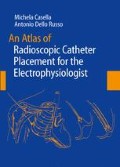Access this chapter
Tax calculation will be finalised at checkout
Purchases are for personal use only
Notes
- 1.
1 A permanent lesion with radiofrequency is created when a 45–50°C temperature is reached at the catheter-myocardium interface, and such a lesion acts on myocardium up to 3–5 mm depth. When higher temperatures are reached, above 60–70°C, clotting and endocardium's carbonization can be produced, with an increased thromboembolic risk, without creating a larger size lesion. Still higher temperatures, closer to 100°C, besides carbonization, can also produce a sudden“boiling”responsible for popping. In order to increase RF lesion volume, it is not necessary to increase temperature at the contact surface which may be done employing catheters with a larger or“irrigated”distal electrode.
- 2.
2 Cryoablation employs cooling to cause tissue damage. A refrigerant gas, usually Freon, runs through the catheter; it chills the catheter's tip creating an ice ball. Myocardial tissue first incurs hypothermia (down to−30°C) causing a temporary lesion. Continued cooling as far as−70–80°C causes intra-cellular ice formation, which causes permanent damage. The first hypothermal phase, also called Cryomapping, is employed to ascertain ablation at that site is effective and safe (for instance, when ablation on anteroseptal accessory pathway one can notice disappearance of preexcitation as well as absence of atrioventricular block along nodal pathways); only in the second phase a irreversible cryo-ablation is carried out. The catheter is held securely to the site by icing and the tissue architecture is preserved avoiding thrombogenic risk. Moreover, cryoablation is usually painless and well tolerated by patients. Cryoablation, however, is reserved at present for special kinds of ablation since the lesion volume is smaller, lesions take much more time to create and are carried out by consecutive points, making thus difficult linear lesions.
Author information
Authors and Affiliations
Rights and permissions
Copyright information
© 2008 Springer-Verlag London Limited
About this chapter
Cite this chapter
Casella, M., Russo, A.D. (2008). Ablation of Supraventricular Tachycardias from the Right Atrium. In: An Atlas of Radioscopic Catheter Placement for the Electrophysiologist. Springer, London. https://doi.org/10.1007/978-1-84800-227-2_4
Download citation
DOI: https://doi.org/10.1007/978-1-84800-227-2_4
Publisher Name: Springer, London
Print ISBN: 978-1-84800-226-5
Online ISBN: 978-1-84800-227-2
eBook Packages: MedicineMedicine (R0)

